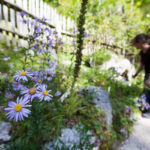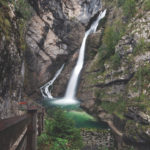Julian Alps
A view of the Soča and the upper Sava river valleys spreads below Mount Triglav, Slovenia’s highest mountain. Lying between the two rivers is Triglav National Park, which protects numerous endemic animal and plant species in a region of high rocky mountains, deeply cut river gorges, high-mountain karst shafts, and attractive low mountains as well as the traditions of the once difficult life of mountain farmers and alpine dairymen.
To the south is the Soča Valley and the gorges of its tributaries. The spots beside the emerald river attract seekers of tranquility as well as those seeking adrenalin challenges. Here, numerous water sports are available, from kayaking and canoeing to rafting and canyoning. Visitors can also experience the valley with parachutes, hang-gliders, and mountain bikes. Slovenia’s highest ski center on Mount Kanin is accessible from the valley where the majority of accommodations and restaurants are to be found in Bovec, Kobarid, and Tolmin. The Posočje region, where every step reveals exceptional natural, also holds emotional memories of the most terrible battles of World War I. They are presented in the Kobarid Museum, which has received numerous awards for excellence. In the upper part of the valley is the picturesque village of Trenta, which hosts the Triglav National Park Information Office, a museum, and the Julijana Botanical Garden, Slovenia’s most important alpine botany center.
In the north side of the Mount Triglav kingdom is the Upper Sava Valley. The popular tourist destination Kranjska Gora attracts summer visitors with opportunities for recreation and sport in nature (hiking, mountaineering, bicycling, horseback riding, paragliding, fishing) and winter visitors with its excellent trails for different kinds of skiing as well as with other winter delights (dog-sledding, night descents on sleds from Mount Vršič, snowmobiling). Guests in Kranjska Gora also enjoy its casino and wellness programs, while children enjoy the original country of the children’s book hero Kekec. In nearby Planica, the best ski jumpers in the world compete each year in the shelter of two-thousand-meter mountains.
The Julian Alps are bejewelled by two picturesque lakes. Bled with its legendary island in the middle of the lake, overlooking castle, hot springs, and beneficial climate has attracted numerous cosmopolitan visitors for centuries. Organized swimming areas, hotels with pools, walking paths, tennis and golf courses, a casino, rowing regattas, a sports airport in Lesce, and the nearby natural and cultural sites provide plenty of reasons for a visit. TheBohinj region with its unspoiled high-mountain lake inspires visitors not only with the beauties of the nature and the Vogel, Kobla, and Soriška planina ski centers but also with its rich ethnological heritage and many interesting cultural and sacral sites. The nearby Pokljuka plateau is a paradise for hikers, mushroom hunters, and cross-country skiers and is the site of major world biathlon competitions.
Authors (from left to right): Boris Pretnar, Franci Ferjan, Mitja Sodja, Jošt Gantar, Aleš Zdešar, Aleš Zdešar, Aleš Fevzer, Jošt Gantar, Matevž Lenarčič, Ana Pogačar, Mitja Sodja, Alen Kosmač Sidarta, Boris Pretnar, Jošt Gantar
Maribor and East Slovenia
Maribor, the capital of the region of Štajerska, is the second largest city in the country but at the same time it is nicely small and green. Its lively throb, superior culture and events, rich wine tradition and the oldest vine in the world, numerous possibilities for entertainment, relaxation and exercise in nature, as well as its reputation of relaxed openness and hospitality also led Maribor to the honorary title of European Capital of Culture 2012.
The city of Maribor merges with the wonderful nature of Pohorje’s forests and picturesque wine growing hills in one of the most attractive tourist destinations in Slovenia.
A quick trip up Pohorje, a green wonder of the Slovenian mountains that attracts hikers, bikers, adrenaline seekers, as well as lovers of peace to Pohorje’s primeval forest, waterfalls, streams and peat moors. During the winter, as the largest ski resort in Slovenia, snow blanketed Mariborsko Pohorje extends a warm welcome.
On wine roads, which from the city centre of Maribor itself criss-cross the hills of Slovenske Gorice and foothills of Pohorje, lovers of excellent wines and cuisine, ethnological heritage, diverse nature and excellent viewing spots that open up views over green countryside and cultural-historic towns come into their own. Tourist homesteads and vineyards await you with homemade culinary delights and genuine hospitality, whether you are on a bike, on foot, on a horse or by car.
Maribor is the host of many top events – from the famous Festival Lent, the wine-culinary Old Vine Festival, the Maribor Theatre Festival, the music Festival of Maribor to the Golden Fox World Cup Skiing competition, and the entire destination also holds many other events.
For those who love being pampered there are modern Wellness programs available, for business guests also topcongressional services, and for gaming fans the entertainment of casinos.
Authors (from left to right): Arhiv Narodni dom, Nikola Jurišič, Iztok Medja, Marko Petrej
Karst
The Karst is the land between the Trieste Bay and the Vipavska Valley and at the same time it is also the name for all the amazing shapes created by waters in the fusible stone. Picturesque karst phenomena can be found in almost half of the area of Slovenia. Besides more than eight thousand known karst caves and potholes, there are also karst springs and intermittent springs, disappearing lakes, swallets and swallow holes, original karst poljes and apparently dry sinkholes.
At the area of Karst and in the region usually called Notranjska there are the most famous caves in Slovenia: the Postojna Cave which is the most visited cave in Europe, the Škocjan Caves, listed in the world natural heritage at Unesco, the Križna jama Cave with its underground lakes, the oldest tourist cave Vilenica near Lokev and all the caves connected with the Postojna Cave – the Pivka Cave, the Črna jama Cave, the Planinska jama Cave, the Otoška jama Cave, the Cave under Predjama Castle and others.
The disappearing Cerknica Lake is of karst nature and when it is full of water it is also the largest of Slovenia’s natural lakes. The unusual Divje jezero Lake near Idrija shares the Karst nature; its waters come from an underground gallery of unique depth. The mysterious lives of karst rivers can be seen in the Rakov Škocjan Regional Park. There is a natural teaching trail in that karst valley with natural stony bridges above the river.
The Karst Snežnik Plateau is also famous for numerous karst phenomena. Lipica, the cradle of famous white Lipizzaner horses, medieval Štanjel with its castle and Fabiani park and many other cultural, ethnological and culinary specialities attract visitors to the region of Karst.
In the Dolenjska and Bela Krajina regions you can discover the mysteries of karst underground as well. The picturesque Krka River has its karst source in the Krška jama Cave, there are the Želnjske jame Caves near Kočevje which are not deep under the surface and the Ledena jama Cave on Stojna with its ice lake during the whole year. The largest of the karst caves of the Dolenjska Region is the easily accessible Kostanjevica Cave. Besides numerous caves and potholes there are large karst poljes, swallow holes and springs which create the image of the landscape. The beauties of the shallow Karst are presented in the Lahinja Regional Park.
A special value of Slovenia are also the alpine Karst phenomena in the Alps. At Kaninski podi there are potholes considered the deepest in the world and you can view karren, grooves and other surface Karst formations. Another peculiarity of the Slovenian Karst is also the Snežna jama Cave under Raduha which reveals mighty underground halls with ice drip-stones and lakes at the 1556 meters above sea level.
Many other underground experiences can also be found in Slovenia. In Šempeter the Pekel Cave, which boasts the highest underground waterfall in Slovenia, surprises its visitors and in the hilly Haloze near Makole there is the geologically interesting Belojača Cave.
Authors (from left to right): Matevž Lenarčič, Dean Dubokovič, Miha Krivič – Postojnska jama d.d., Nea Culpa d.o.o.
Istria – the sea side
The Slovene coast which measures 46.6 kilometres is covered with abundant vegetation. Here is a natural reserve with a rich supply of marl and sandstone and the unique Strunjan cliff which ascends 80 metres above the sea and is the highest flysch wall on the Adriatic coast. Here are the Sečovlje saltworks, first mentioned in the 13th century. Due to their extremely abundant natural and historical heritage they were named a regional park and are a rich sanctuary of plant and animal worlds. They play a very important role in the world of ornithology, because they offer ideal conditions for birds due to the warm climate and abundance of food in the saltwork pools. So about 200 bird species have been seen at the saltworks and they provide a natural habitat for about 80 bird species which nest there.
Here the towns of Piran, Izola and Koper attract visitors with their medieval image. Koper with its historical core represents one of the most picturesque parts of the northern part of the Istrian Peninsula. Water sports are very important; there are many regattas in the Bay of Koper and the town has built a small marina. It also organises the Summer Festival of Primorska. The town’s surroundings and the countryside are exceptionally attractive: the steep rock walls by Črni Kal and Osp provide an ideal place for lovers of free climbing and the countryside “ boasts” specific culinary and wine offers.
Izola is a coastal town with a rich fishing tradition. Most of the tourism is concentrated on the eastern side, at the bay Simonov zaliv, where there is a seaside resort with swimming facilities, hotels and restaurants. On the western edge of the town is the marina of Izola.
The old seaport of Piran lies at the end of the Piran peninsula; it was surrounded by walls in the Middle Ages (200 metres of the city walls are still preserved). The whole town is protected as a cultural and historical monument and it has preserved its medieval layout with narrow streets and compact houses, which rise in steps from the coastal lowland into the hills and give the whole area a typical Mediterranean look. Today it is an administrative and supply centre and also an important coastal tourist resort with hotels, restaurants and holiday houses, the Sergej Mašera Maritime Museum and an aquarium, cultural institutions and events.
Portorož, a tourist town which boasts the longest tourist tradition in Slovenia and offers comfortable hotels and modern swimming pools, restaurants and events. It is a popular conference centre – various conference and meeting facilities can accommodate up to 1500 visitors. Portorož has a casino, a sport airport and marina. It is a town visited by tourists from all over Europe and other countries as well. It is an internationally known holiday centre and climatic health seaside resort.
In the Šavrinska Hills in the hinterland of Portorož lies a number of old Istrian settlements (Padna, Krkavče, Koštabona, Pomjan, Gažon), and not far from the coast there is the picturesque village Hrastovlje with its Church of the Holy Trinity which is adorned by late gothic narrative frescoes. Due to these Hrastovlje is considered as a real treasure of medieval frescoe arts in Slovenia.
Authors (from left to right): Jaka Ivančič, Tadej Bernik, Jure Kravanja, Darinka Mladenovič, Jošt Gantar, Jaka Ivančič




























